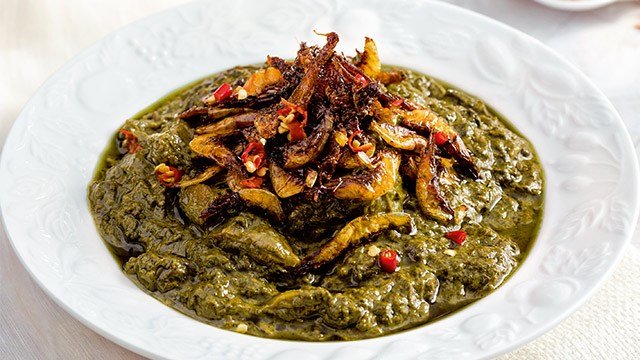Laing with Shrimp
Laing is a well-loved Bicolano dish that is savory, creamy, earthy, and spicy all at once! It's one of the most iconic dishes in Bicolano cuisine because of the various bursts of flavors. Cooked in cocunut milk, laing is sure to be the perfect dish for a stay in weekend meal. The secret to the best laing? Leave it to simmer gently for more than an hour to allow the flavors to develop. This simple-to-follow recipe will definitely make your dinner table stand out. Here's a tip: Top it off with crispy shrimp to give it a nice crunch.

- 2 tablespoons vegetable oil
- 500 grams pork, diced
- 500 grams pork, diced
- 2 tablespoons ginger, cut into strips
- 2 pieces green finger chili (siling pangsigang)
- 3 cups coconut cream (kakang gata)
- 3 cups taro leaves (dahon ng gabi), use dried leaves
- 2 cups pork stock
- black pepper, to taste
- siling labuyo (bird's eye chili), sliced
- 1 cup dried shrimp (hibe), or hibe
- 1 tablespoon vinegar
Ingredients:
Traditional way of cooking
Procedure
- Heat oil in a large pot. Fry pork until browned. Set pork aside.
- In the same pot, sauté onions, garlic, ginger, and chilies. Add coconut cream; simmer for 25 minutes. Bring mixture to a boil. Add taro leaves; mix. Add stock; simmer, stirring occasionally, for 1½ hours or until leaves are soft and wilted. Season with salt and pepper. Mix in fried pork.
- Make the crispy shrimp: Heat oil in a pan. Fry shrimp for 2 minutes. Add sugar and vinegar. Cook for 2 more minutes. Drain and set aside
- Transfer laing to a serving plate. Top with crispy shrimp and garnish with chilies, if desired.
Bicol is a region in the Philippines encompassing the southern part of Luzon Island and nearby island provinces. Caramoan, a peninsula in the east, is dotted with caves, limestone cliffs and white-sand beaches. Nearby, Catanduanes Island has mountains, waterfalls and coral reefs. Donsol, in the west, is home to whale sharks. The region's active volcanoes include Bulusan Volcano and Mayon Volcano.

